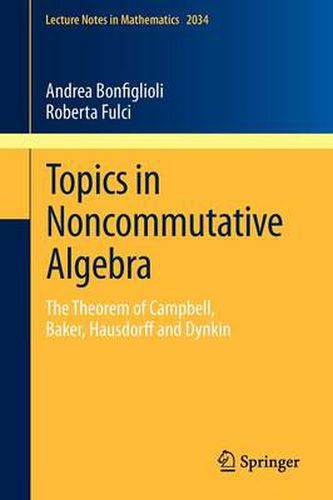Readings Newsletter
Become a Readings Member to make your shopping experience even easier.
Sign in or sign up for free!
You’re not far away from qualifying for FREE standard shipping within Australia
You’ve qualified for FREE standard shipping within Australia
The cart is loading…






This title is printed to order. This book may have been self-published. If so, we cannot guarantee the quality of the content. In the main most books will have gone through the editing process however some may not. We therefore suggest that you be aware of this before ordering this book. If in doubt check either the author or publisher’s details as we are unable to accept any returns unless they are faulty. Please contact us if you have any questions.
Motivated by the importance of the Campbell, Baker, Hausdorff, Dynkin Theorem in many different branches of Mathematics and Physics (Lie group-Lie algebra theory, linear PDEs, Quantum and Statistical Mechanics, Numerical Analysis, Theoretical Physics, Control Theory, sub-Riemannian Geometry), this monograph is intended to: fully enable readers (graduates or specialists, mathematicians, physicists or applied scientists, acquainted with Algebra or not) to understand and apply the statements and numerous corollaries of the main result, provide a wide spectrum of proofs from the modern literature, comparing different techniques and furnishing a unifying point of view and notation, provide a thorough historical background of the results, together with unknown facts about the effective early contributions by Schur, Poincare, Pascal, Campbell, Baker, Hausdorff and Dynkin, give an outlook on the applications, especially in Differential Geometry (Lie group theory) and Analysis (PDEs of subelliptic type) and quickly enable the reader, through a description of the state-of-art and open problems, to understand the modern literature concerning a theorem which, though having its roots in the beginning of the 20th century, has not ceased to provide new problems and applications.
The book assumes some undergraduate-level knowledge of algebra and analysis, but apart from that is self-contained. Part II of the monograph is devoted to the proofs of the algebraic background. The monograph may therefore provide a tool for beginners in Algebra.
$9.00 standard shipping within Australia
FREE standard shipping within Australia for orders over $100.00
Express & International shipping calculated at checkout
This title is printed to order. This book may have been self-published. If so, we cannot guarantee the quality of the content. In the main most books will have gone through the editing process however some may not. We therefore suggest that you be aware of this before ordering this book. If in doubt check either the author or publisher’s details as we are unable to accept any returns unless they are faulty. Please contact us if you have any questions.
Motivated by the importance of the Campbell, Baker, Hausdorff, Dynkin Theorem in many different branches of Mathematics and Physics (Lie group-Lie algebra theory, linear PDEs, Quantum and Statistical Mechanics, Numerical Analysis, Theoretical Physics, Control Theory, sub-Riemannian Geometry), this monograph is intended to: fully enable readers (graduates or specialists, mathematicians, physicists or applied scientists, acquainted with Algebra or not) to understand and apply the statements and numerous corollaries of the main result, provide a wide spectrum of proofs from the modern literature, comparing different techniques and furnishing a unifying point of view and notation, provide a thorough historical background of the results, together with unknown facts about the effective early contributions by Schur, Poincare, Pascal, Campbell, Baker, Hausdorff and Dynkin, give an outlook on the applications, especially in Differential Geometry (Lie group theory) and Analysis (PDEs of subelliptic type) and quickly enable the reader, through a description of the state-of-art and open problems, to understand the modern literature concerning a theorem which, though having its roots in the beginning of the 20th century, has not ceased to provide new problems and applications.
The book assumes some undergraduate-level knowledge of algebra and analysis, but apart from that is self-contained. Part II of the monograph is devoted to the proofs of the algebraic background. The monograph may therefore provide a tool for beginners in Algebra.